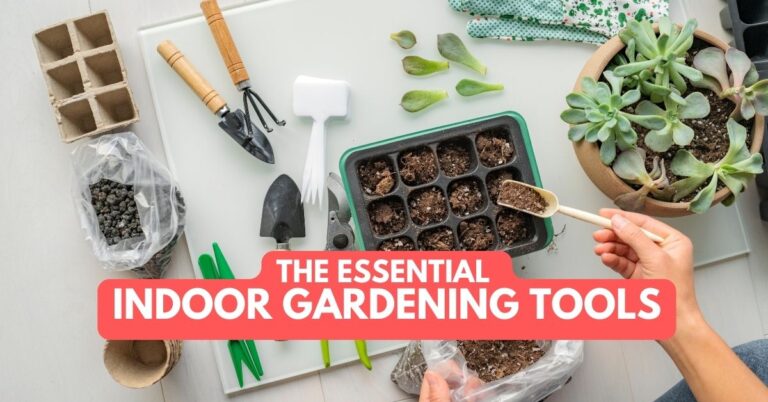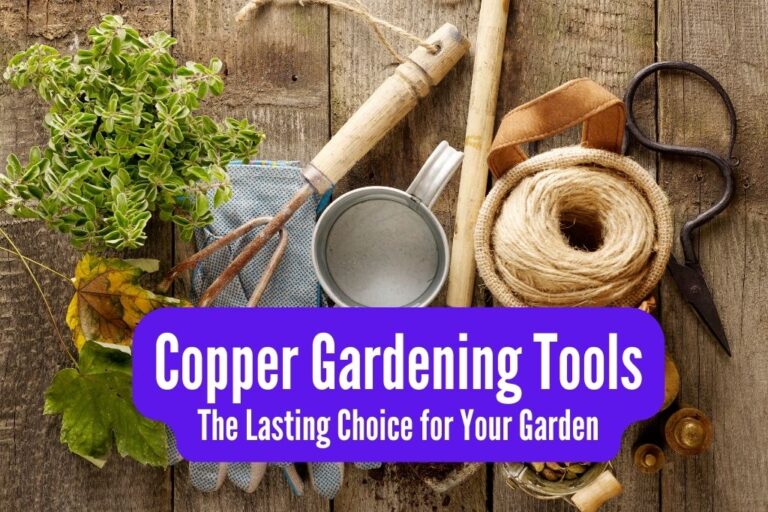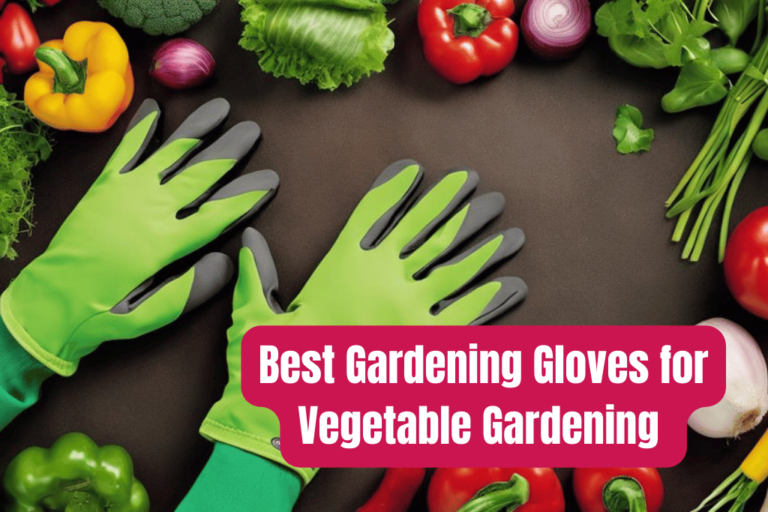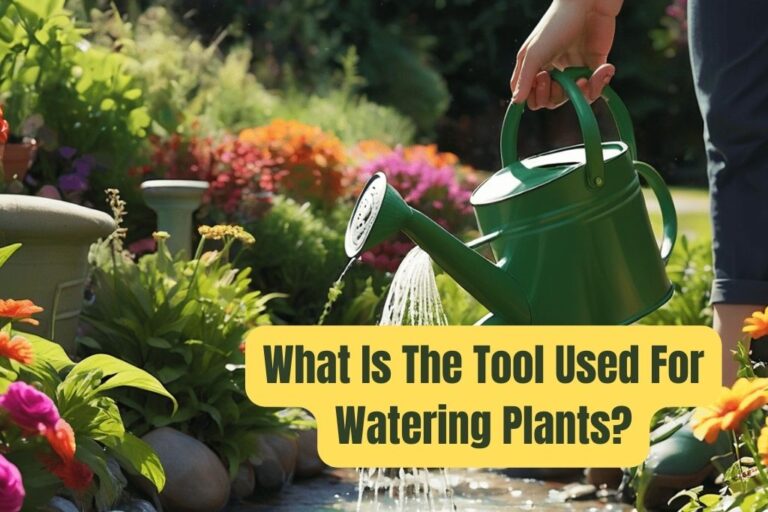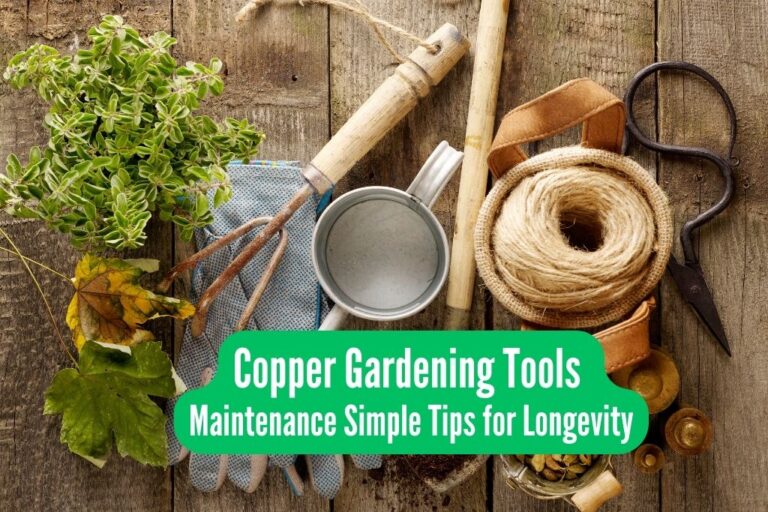How to Care for Gardening Gloves
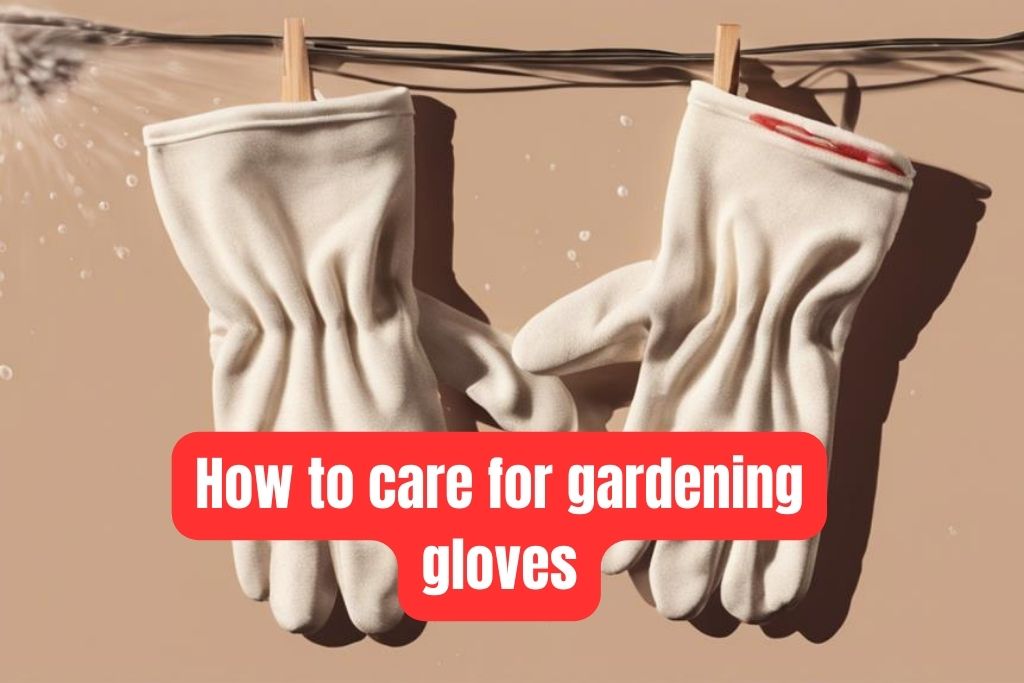
Care for your gardening gloves by choosing durable materials like leather or synthetics, cleaning with mild soap, and drying in a well-ventilated area. Store them away from direct sunlight for longevity. Ensure proper sizing for comfort and performance. Enhance durability by repairing small tears promptly and inspecting for wear. Add thin cotton gloves underneath for sweat absorption. Look for adjustable wrist closures and padded palms for comfort. Rotate gloves and apply UV protectant spray for fabric protection. For touchscreen compatibility, choose gloves without removal. Remember, additional tips can help maintain your gardening gloves in top condition.
Choosing the Right Material
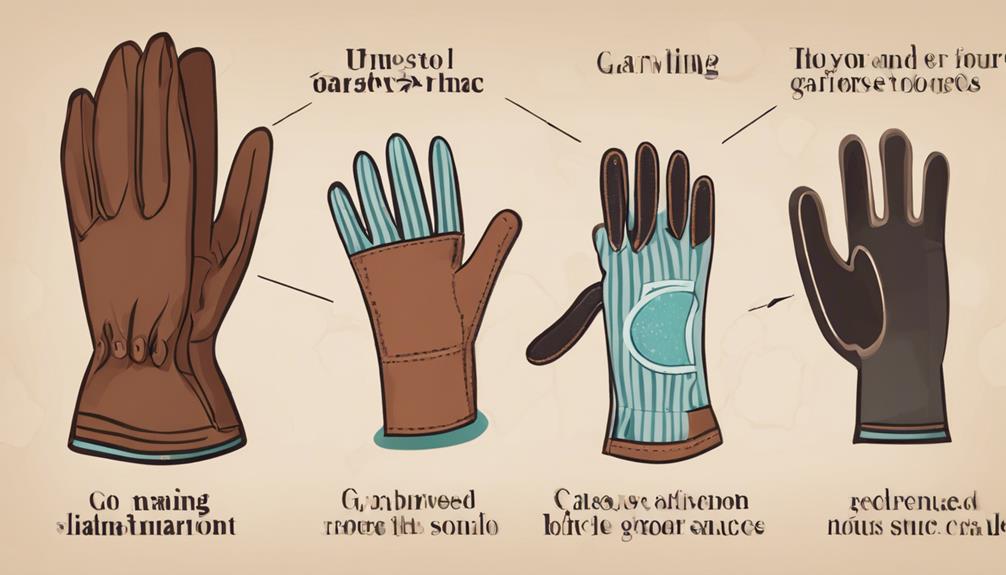
When selecting gardening gloves, prioritize materials that offer durability and flexibility. Opt for gloves made from sturdy leather or tough synthetic fabrics. These materials provide the freedom to move your hands comfortably while protecting them from thorns, sharp tools, and dirt.
Leather gloves are a classic choice, offering excellent durability and a natural feel. They mold to your hands over time, providing a personalized fit that enhances your gardening experience.
If you prefer vegan options, synthetic gloves made from materials like neoprene or nylon are also great choices. They’re easy to clean, quick-drying, and offer exceptional flexibility. Some synthetic gloves even come with touchscreen-compatible fingertips, allowing you the freedom to use your devices without removing your gloves.
Consider the tasks you’ll be doing in the garden and choose a material that suits your needs best. Prioritizing durability and flexibility ensures that your gloves will withstand the rigors of gardening while giving you the freedom to work comfortably.
Cleaning Techniques
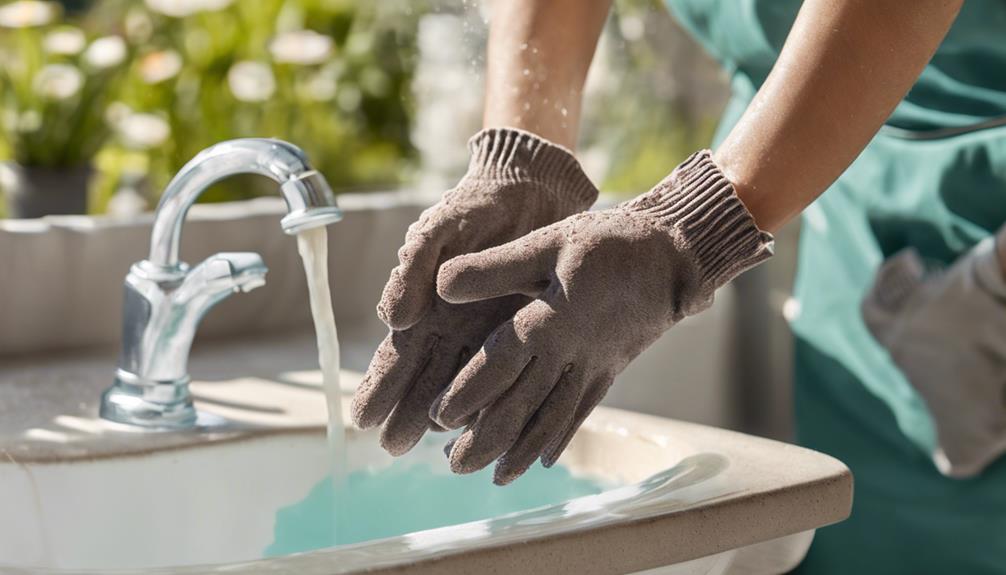
To maintain the longevity of your gardening gloves, regularly clean them using appropriate techniques. Keeping your gloves clean not only extends their lifespan but also ensures a comfortable and effective gardening experience.
Start by checking the care instructions provided by the manufacturer to determine the best cleaning method for your specific gloves. For most gloves, gently hand washing them with mild soap and lukewarm water is a safe bet. Avoid harsh chemicals or bleach that could damage the material.
If your gloves are particularly dirty or have stubborn stains, you can use a soft brush or cloth to scrub them gently. For leather gloves, consider using a specialized leather cleaner to maintain their quality.
After cleaning, make sure to thoroughly rinse off all soap residue and allow the gloves to air dry completely before storing them.
Drying Methods
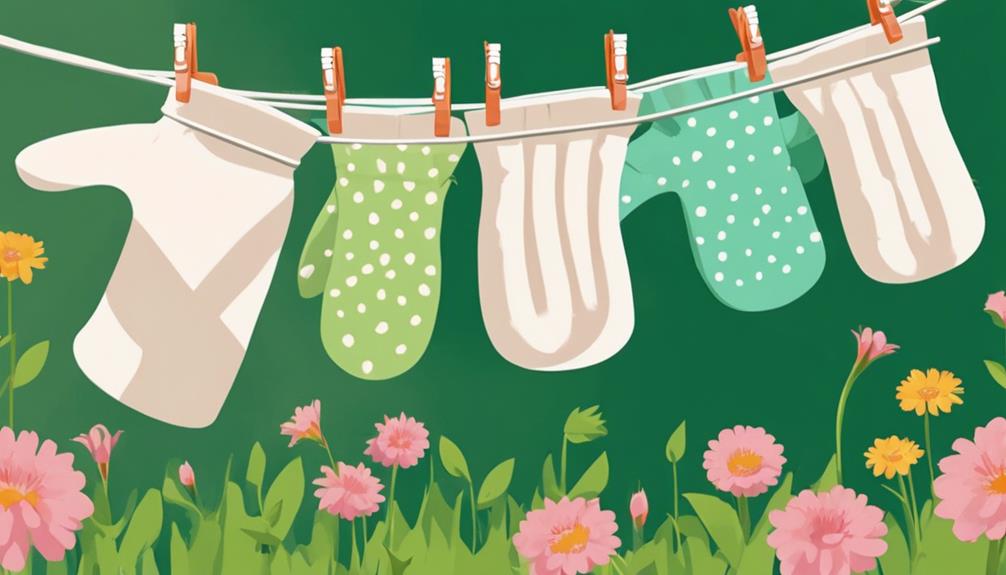
After cleaning your gardening gloves, ensure they’re thoroughly dried before storing them to prevent mold or mildew growth.
To dry your gloves effectively, the simplest method is to hang them in a well-ventilated area. You can use a clothesline, a hook, or even a sturdy branch outdoors. Just make sure they’re out of direct sunlight to prevent any damage to the fabric.
If you need your gloves to dry quicker, you can place them on a drying rack or a mesh surface. This allows air to circulate around the gloves, speeding up the drying process. Another option is to use a fan to blow air over the gloves, helping them dry faster.
Avoid using a dryer or any direct heat source, as this can damage the material of the gloves. Remember, the goal is to dry them gently and naturally.
Once your gardening gloves are completely dry, they’ll be ready for your next gardening adventure.
Storage Solutions
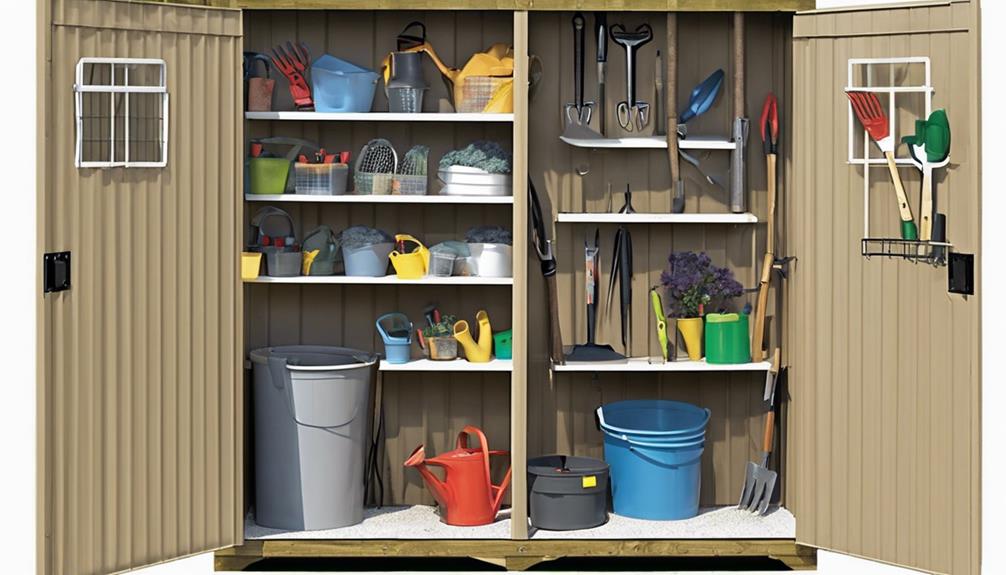
Ensure your gardening gloves remain in good condition by implementing effective storage solutions. To keep them ready for your next gardening session, find a designated spot for your gloves that’s cool, dry, and out of direct sunlight.
Avoid leaving them in a damp or humid area, as moisture can lead to mold and mildew growth. Hanging your gloves on hooks or a pegboard is a great way to prevent them from getting misplaced or damaged. If you prefer storing them in a container, make sure it’s breathable to prevent trapped moisture. Consider using a mesh bag or a breathable fabric pouch for storage.
Additionally, keeping your gloves away from sharp objects or chemicals will help maintain their durability and functionality. By taking a few simple steps to store your gardening gloves properly, you can ensure they stay in top condition and ready to use whenever you need them.
Repairing Small Tears
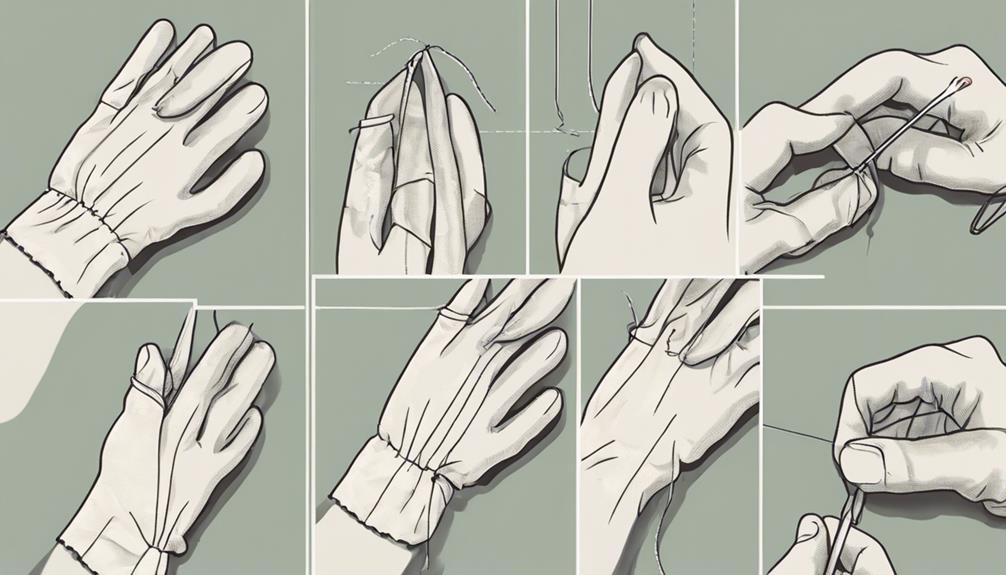
Maintain the longevity of your gardening gloves by promptly addressing any small tears that may occur during use. Small tears can lead to bigger issues if left unattended, so here are some simple steps to help you repair them and keep your gloves in good condition:
- Clean the Area: Before attempting any repairs, make sure the tear is clean from dirt and debris to ensure a better fix.
- Apply a Patch: Use a strong adhesive patch or fabric tape to cover the tear and prevent it from getting larger.
- Stitching: If the tear is along a seam, you can reinforce it by stitching the affected area with a needle and strong thread.
- Seal the Edges: To prevent further fraying, apply a fabric sealant or clear nail polish along the edges of the tear.
Preventing Mold and Mildew
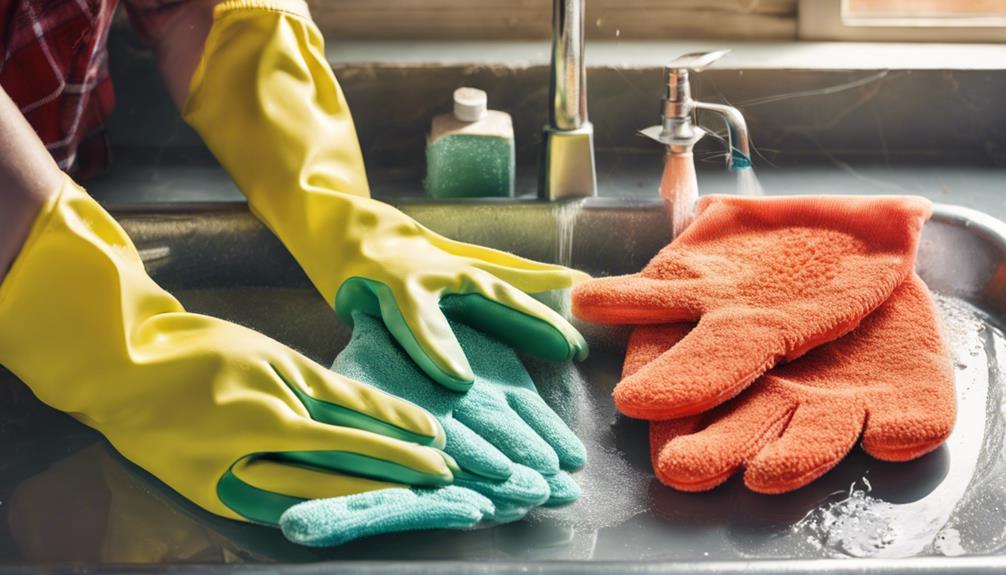
To safeguard your gardening gloves from mold and mildew, proper storage and regular cleaning are essential. After a day of digging and pruning, it’s tempting to toss your gloves aside, but that can lead to moisture buildup and mold growth.
Instead, shake off any excess dirt and let them air out before storing them in a cool, dry place. Avoid leaving them in a damp shed or crammed in a sweaty glove box.
When it comes to cleaning, a simple solution of mild soap and water will do the trick. Gently scrub the gloves and rinse thoroughly before allowing them to dry completely.
If you notice any mold or mildew starting to form, tackle it immediately by scrubbing with a mixture of vinegar and water.
Dealing With Stains
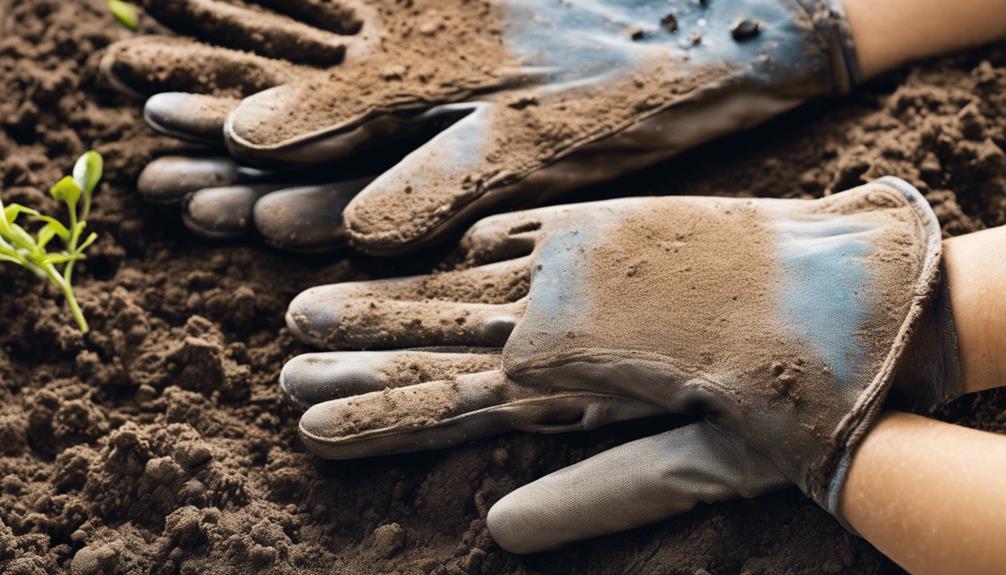
If you encounter stubborn stains on your gardening gloves, tackle them promptly to ensure they remain in good condition. Whether it’s dirt, sap, or other common garden grime, here are some simple steps to help you deal with stains effectively:
- Immediate Action: Rinse the stained area with cold water as soon as possible to prevent the stain from setting.
- Mild Soap Solution: Gently scrub the stained area with a mild soap solution to lift the stain without damaging the fabric.
- Spot Treatment: For tougher stains, consider using a stain remover specifically designed for the type of stain on your gloves.
- Air Dry: After cleaning, allow your gardening gloves to air dry completely before using them again to prevent any lingering stains from setting further.
Maintaining Grip
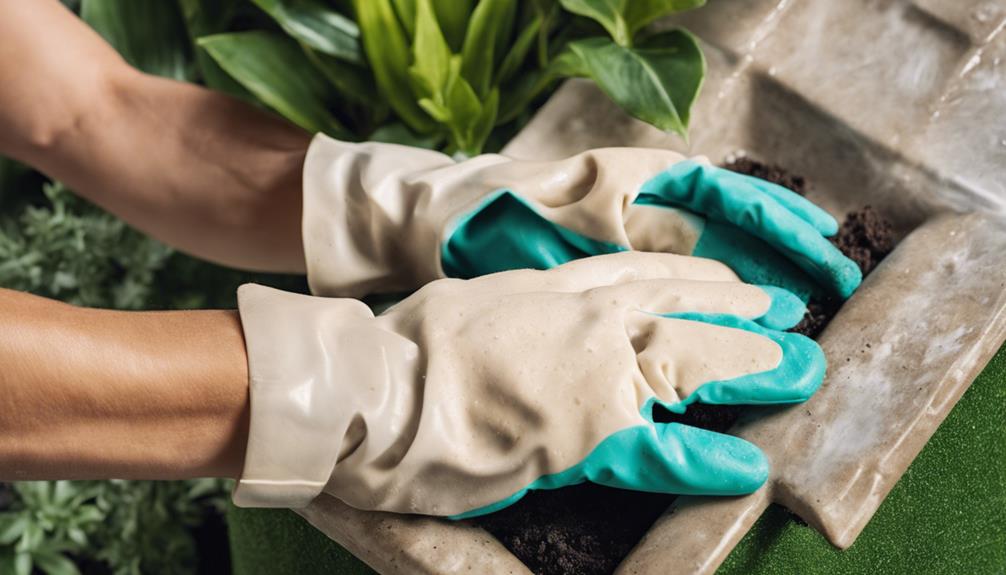
When handling gardening tasks, ensuring a secure grip on your gloves is vital to prevent accidents and maintain control over your tools. To maintain a good grip on your gardening gloves, regularly check the condition of the palm and finger areas.
Over time, dirt and debris can accumulate, reducing the effectiveness of the grip. You can clean the gloves using a mild soap and water solution, making sure to rinse thoroughly and allow them to air dry.
If you notice the grip on your gloves starting to wear out, you can enhance it by applying a specialized grip-enhancing spray or solution. These products are designed to rejuvenate the palm and finger areas of the gloves, providing you with better traction while working in the garden.
Additionally, choosing gloves with textured palms or fingers can also help improve grip. By taking these simple steps, you can ensure that your gardening gloves maintain a strong grip, giving you the freedom to work efficiently and safely in your garden.
Avoiding Harsh Chemicals
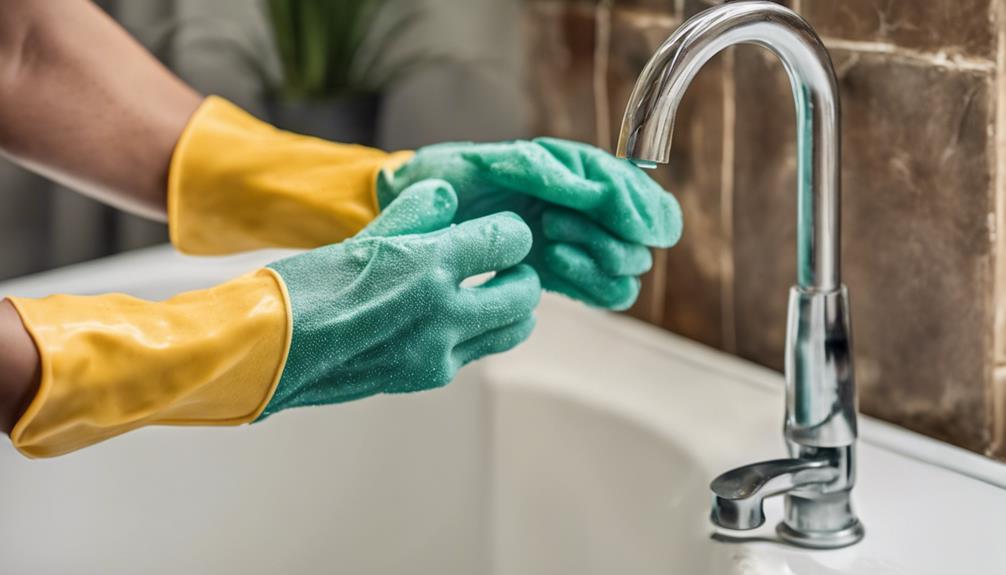
Are you aware of the importance of avoiding harsh chemicals when caring for your gardening gloves? It’s crucial to keep your gloves in top condition while also being mindful of the environment.
Here are some simple yet effective tips for steering clear of harsh chemicals when maintaining your gardening gloves:
- Use Natural Cleaning Agents: Opt for natural substances like vinegar or baking soda to clean your gloves instead of harsh chemical cleaners.
- Avoid Bleach: Bleach can be harmful to both your gloves and the environment, so it’s best to steer clear of it.
- Read Labels Carefully: When purchasing cleaning products, make sure to read the labels and choose ones that are gentle and eco-friendly.
- Consider DIY Solutions: Get creative and make your own glove-cleaning solutions using simple ingredients like mild soap and water.
Washing Frequency
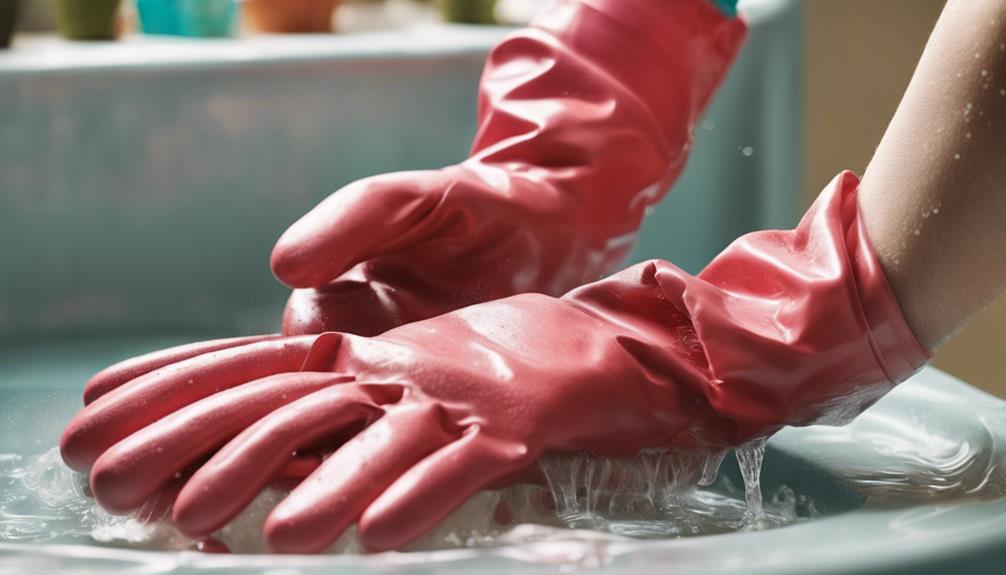
Maintaining the cleanliness of your gardening gloves through regular washing is essential for prolonging their lifespan and ensuring optimal performance. To keep your gloves in top condition, aim to wash them after each use, especially if they’ve been exposed to dirt, chemicals, or moisture.
When washing your gloves, follow the care instructions provided by the manufacturer if available. If not, a general rule of thumb is to hand wash them using mild soap and lukewarm water. Gently scrub any heavily soiled areas and rinse thoroughly to remove all soap residue.
Avoid using harsh chemicals or bleach, as these can damage the fabric and affect the glove’s performance. After washing, reshape the gloves and allow them to air dry completely before storing them in a cool, dry place.
Sun Protection
Protect your gardening gloves from sun damage by storing them in a shaded area when not in use. Sun exposure can weaken the fabric and cause colors to fade, reducing the lifespan of your gloves.
To ensure your gloves stay protected, follow these tips:
- Use a UV protectant spray: Apply a UV protectant spray specifically designed for fabrics to shield your gloves from the sun’s harmful rays.
- Rotate between multiple pairs: Having multiple pairs of gloves allows each pair to have time to rest in the shade, extending their longevity.
- Choose gloves with UPF protection: Select gloves with a high Ultraviolet Protection Factor (UPF) to provide built-in sun protection.
- Avoid leaving gloves in hot vehicles: High temperatures in cars can accelerate sun damage, so take your gloves with you instead of leaving them in the vehicle.
Inspecting for Wear and Tear
Regularly check your gardening gloves for signs of wear and tear to ensure they remain in good condition for longer use. Inspecting your gloves is crucial to prevent unexpected rips or holes that can compromise their effectiveness.
Start by examining the palms and fingertips, as these areas tend to experience the most friction and wear. Look for any holes, thinning fabric, or loose stitching that could indicate potential issues. Additionally, inspect the seams and cuffs for any signs of unraveling or damage.
If you notice any wear and tear during your inspection, consider repairing the gloves promptly to prevent further deterioration. Small holes can often be easily patched up with a needle and thread, while loose stitching can be reinforced to extend the life of your gloves.
Proper Sizing
Check that your gardening gloves fit properly to ensure optimal comfort and protection while working in the garden. Ill-fitting gloves can cause blisters, make it challenging to grip tools, and may not provide adequate protection against thorns or sharp objects.
To ensure the right fit, follow these tips:
- Try Before You Buy: Make sure to try on different sizes before purchasing to find the best fit for your hands.
- Consider the Material: Different glove materials can affect the fit, so be mindful of how they stretch or conform to your hands.
- Check the Fingertip Length: Ensure the glove fingertips reach the end of your fingers without being too short or too long.
- Test Movement: Move your fingers and hands around while wearing the gloves to ensure they allow for comfortable movement without restricting you.
Enhancing Comfort
To ensure maximum comfort while wearing your gardening gloves, consider additional ways to enhance your overall gardening experience. First, try wearing a thin pair of cotton gloves underneath your gardening gloves. This extra layer can help absorb sweat and prevent any irritation that might occur from prolonged wear.
Additionally, look for gloves with adjustable wrist closures to ensure a snug fit that keeps dirt and debris out while providing flexibility for movement. Choosing gloves with padded palms can also help reduce fatigue and provide extra cushioning during tasks that require repetitive motions.
Furthermore, consider investing in gloves with breathable materials like mesh or perforations to keep your hands cool and dry, especially during hot weather. Some gloves even come with touchscreen compatibility, allowing you to use your devices without removing them.
Long-Term Maintenance
For optimal durability and performance, it’s essential to properly care for your gardening gloves in the long term. To ensure your gloves stay in top condition and provide you with the protection you need, follow these simple maintenance tips:
- Clean Regularly: After each use, gently wash your gloves with mild soap and water to remove dirt and debris. Air dry them thoroughly before storing.
- Inspect for Damage: Regularly check your gloves for any tears, holes, or worn-out areas. Repair small damages promptly to prevent them from worsening.
- Store Properly: Keep your gloves in a cool, dry place away from direct sunlight when not in use. Avoid storing them in damp or humid conditions.
- Rotate Pairs: If you use your gardening gloves frequently, consider having multiple pairs on hand. Rotating between gloves can help extend their lifespan by reducing wear and tear on a single pair.
Frequently Asked Questions
Can Gardening Gloves Be Used for Other Tasks Besides Gardening?
Yes, gardening gloves can be used for various tasks beyond gardening. They offer protection for activities like cleaning, painting, and DIY projects. Remember to wash them as needed to maintain their durability and hygiene.
Are There Specific Gloves for Different Types of Gardening Tasks?
When tackling various gardening tasks, specific gloves can enhance your experience. Pruning roses? Opt for thorn-proof gloves. Mucking out the compost? Grab some waterproof ones. Choose the right gloves for each job!
How Can I Prevent My Gloves From Getting Stiff Over Time?
To prevent your gloves from getting stiff over time, remember to clean and air dry them after use. Applying a leather conditioner or using a fabric softener can also help maintain their flexibility and durability.
Can I Machine Wash My Gardening Gloves With Other Laundry?
You can machine wash your gardening gloves with other laundry, but it’s best to check the manufacturer’s instructions first. Some gloves may require hand washing or specific care to maintain their quality and durability.
How Do I Know When It’s Time to Replace My Gardening Gloves?
When it’s time to replace your gardening gloves, look for signs like holes, tears, or worn-out areas. If they no longer protect your hands or offer proper grip, it’s time for a new pair.
Conclusion
Congratulations! You now know how to care for your gardening gloves like a pro.
Remember, the key to keeping them in top shape is to neglect them completely and throw them in a dark, damp corner. Just kidding!
Follow these simple tips to ensure your gloves last a lifetime and keep your hands protected while you get your hands dirty in the garden.
Happy gardening!
Content are generated with AI, fact checked by editorial team.
Hi there! My name is Aaron and I am a gardening expert from the United States. I have always had a passion for gardening and have been practicing it for years. I have gained extensive knowledge and experience in gardening.

